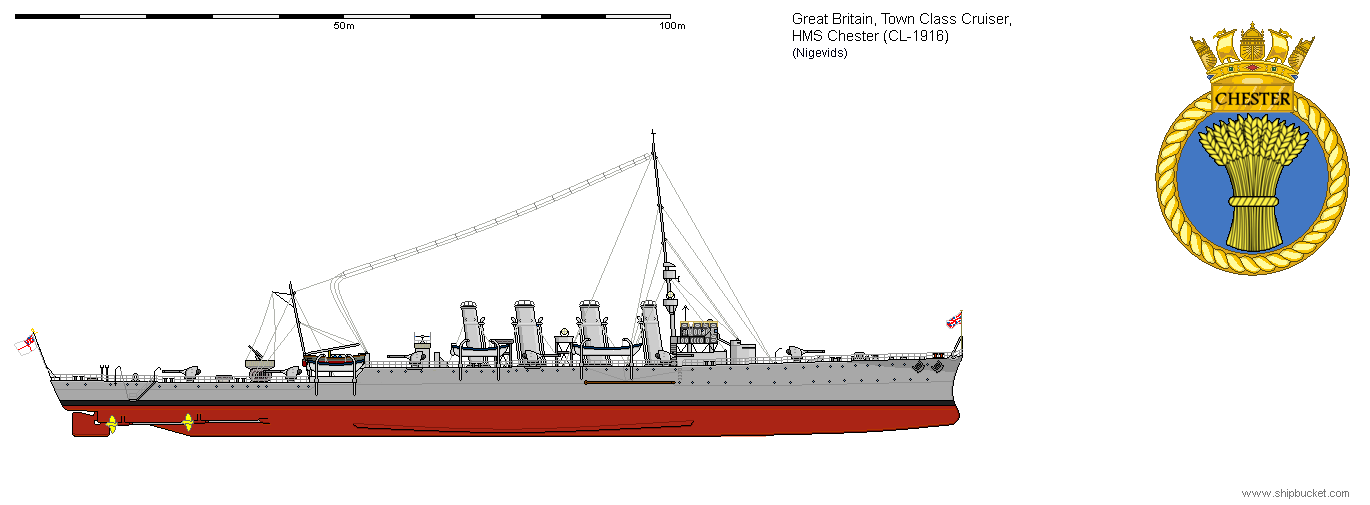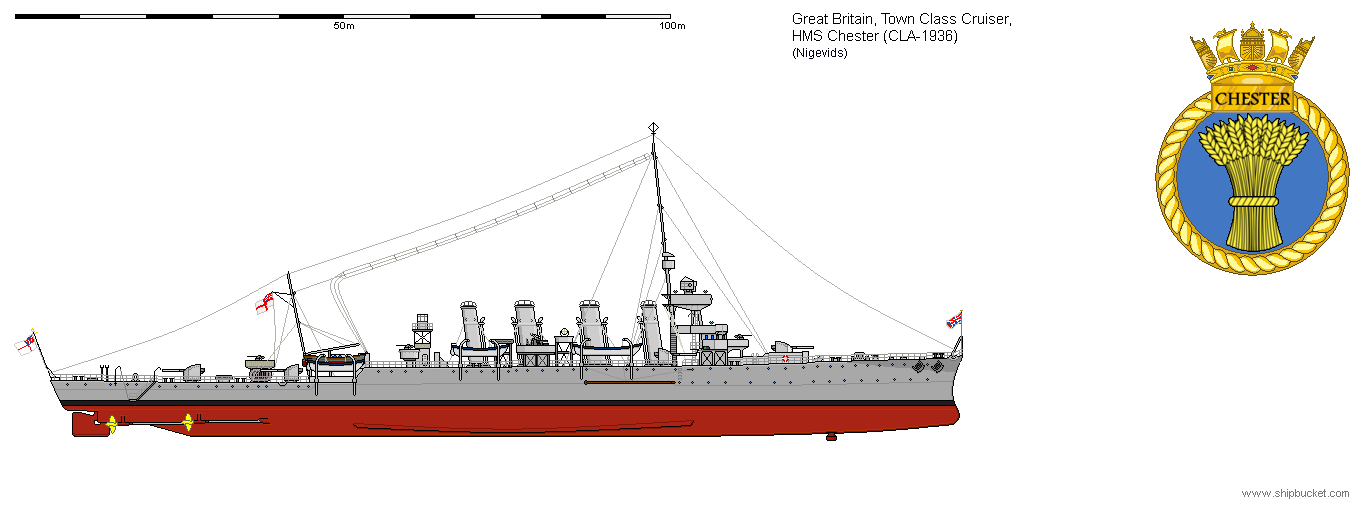The Birmingham Class was envisaged as a class of four, with three British and one Australis members. A year later the Greeks ordered two for their Navy to a modified design. The Commonwealth original design had nine 6", while the Greek ships were to be armed with ten 5.5". On the outbreak of World War One, the two Greek ships were taken over for the Royal Navy. The three British ships were completed in 1914 while the Australis and Greek ships were completed in 1916.
The British ships followed the layout of the previous Chatham class, with the foredeck carrying two 6" instead of one. Eventually the two single guns on the foredeck were replaced with a light turret that had been trialled on the 'D' class ships. The three British ships went out to the Commonwealth Navies after 1920-21. Australis retained their ship and converted it to patrol duties in the mid-thirties. Various refits during the 1920's and 1930's altered the ships in different manners and for different assignments. By the time the remaining five ships of the class hit World War Two, none of the ships were exactly alike any more.
The Birminghams and Bendigo.

1914 and the three British Birminghams being some of the most modern cruisers around, they were all with the Grand Fleet.
On 9 August 1914, the Birmingham spotted the U-15, whose engines had failed as it lay stopped on the surface in heavy fog, off Fair Isle. The crew of Birmingham could hear hammering from inside the boat from attempted repairs, and so fired on it but missed. As the U-boat began to dive, Birmingham rammed it, cutting it in two. U-15 went down with all hands, the first U-boat loss to an enemy warship. Birmingham also sank two German merchant ships that year and took part in the Battle of Helgoland on 28 August, and the Battle of Dogger Bank in January 1915. In February, Birmingham joined the 2nd Light Cruiser Squadron, attacking a U-boat on 18 June 1915 without success. At Jutland, Birmingham received splinter damage during the night action. Lowestoft mimicked Birminghams service postings till after Jutland when the trio were broken up after the Nottingham was torpedoed by a U-Boat. Lowestoft went on to serve in the Mediterranean and Adriatic with the 8th Cruiser Squadron and rejoined Birmingham after the end of the war when both ships were sold to the Southern African Navy.

Service with the Southern African Navy started as full cruisers until the late 1920's when new ships joined the SANavy and the Bloemfontein and Waterberg started the long slippery slide down the ranks of duties. When received in 1921 the armament had gone from the original 9x6" to 6x6" and 2x4" AA with a four gun six inch broadside. Their final armament still gave them a four gun broadside, but the guns were now all on the centreline, the broadside guns being removed. The two SANavy ships finished as training and escort cruisers and spent most of their war escorting convoys from Cape Town / Simonstown through to Sierra Leone. Waterberg was lost on this duty in 1941 when torpedoed by a U-boat off Sierra Leone.

The HMAS Bendigo was the sole Australis Birmingham class cruiser. The ship was built to be the leader of the Australis 1st Light Cruiser Squadron with a bit more accommodation for the Senior Captain or Commodores extra staff. The Bendigo went through the 20's and 30's losing six inch guns on a regular basis and ending up as a training ship acting with the Training squadron in and outside of Port Philip Bay near Melbourne. Once the first Albatross class Escort Carriers started completing, it was decided the Bendigo would be converted as Squadron Flagship and heavy escort. The ship would be the centre of an escort group.

The Chester and Birkenhead.
While the Chester was an offshoot of the Town Class cruiser lineage, it was built and completed at the same time as the Cambrian class in the 1915-16 period. Both Birkenhead and Chester were completed to slightly different specifications. The main difference being in the propulsion systems, Birkenhead was of mixed coal/oil fired boilers giving 25,000shp for 25 knots, while the Chester was oil fired throughout which produced more power at 31,000shp for 26.5 knots. The Chester sailed into fame at Jutland with boy Cornwell's VC. At wars end both ships were offered back for sale to Greece who declined. Birkenhead was sold in 1921 to Peru and replaced the old cruiser Almirante Grau. Chester was kept as part of the training squadron for 2 years and was then again offered for sale as the ship was a problem with the 5.5" guns while virtually all of the other RN light cruisers were armed with 6". What saved Chester from the scrapyard was the ordering of the 'G' class cruisers and Majestic Class battleships which were to be armed with the 5.5" gun.
First drawing is of Chester as it appeared at Jutland May 1916.

After service as a training ship, HMS Chester is converted to an Anti-Aircraft ship with the new 4.5"/4.7" DP weapons. (weapons depend on which scenario is being followed)
